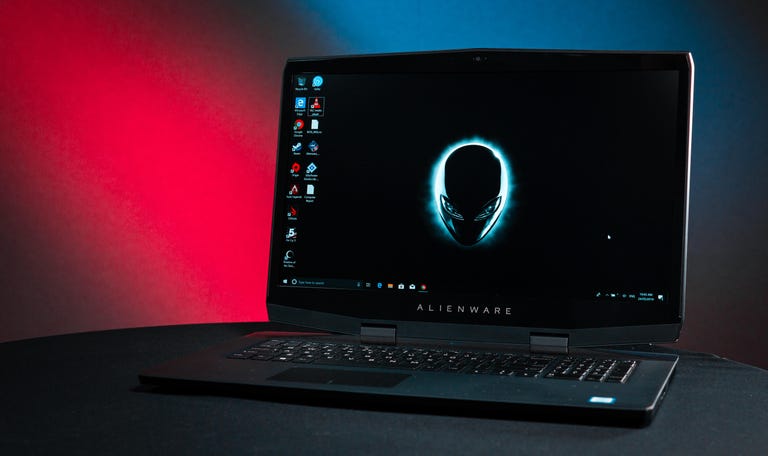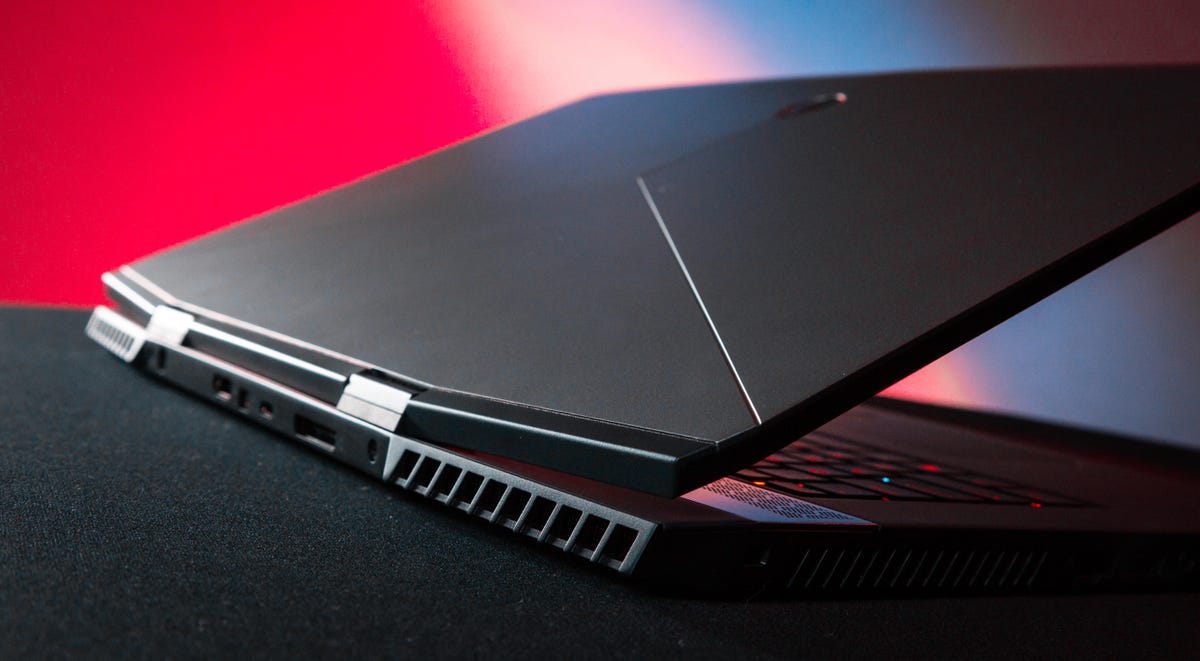 Why You Can Trust CNET
Why You Can Trust CNET Alienware m17 review: An Alienware all grown up
The m17 doesn't have the gaudy looks you'd expect from Alienware, but it has the power you're after.
The first thing you notice about the m17 is how little it feels like an Alienware laptop.
The Good
The Bad
The Bottom Line
Recent years have pushed gaming laptops towards being thinner, lighter and slicker. Alienware always seemed a little resistant to this trend, with laptops that often resemble gaming warships. They're proud of their cultural heritage and diametrically opposed to blending in a professional or college environment.
The Alienware m17, like the smaller m15 , is more reserved laptop than recent designs like the R5 and certainly the Area-51m. It's pleasantly lithe and portable for a 17-inch gaming laptop. As a matter of fact, it's lighter than Razer's new 17-inch Pro laptop.
But it is still a giant. The m17 line is powered by Nvidia's new RTX 20-series graphics cards, which were introduced in laptops in January. These GPUs pump out more horsepower and are specialized for nifty graphical tricks like raytracing (jargon for reflecting moving light on a person or object).
At the top end of the line is an m17 with a Max-Q RTX 2080, currently the most powerful GPU you can get in a laptop. That variant, which also comes with a six-core, eighth-gen Core i7-8750 processor and a 2,560x1,440 quad-HD display, is the one we received for review. You can configure it with cheaper RTX 2060 and 2070 graphics -- or you can go the other way and cram an ultrapowerful Core i9-8950HK CPU in there, boost the RAM to 32GB and dual 1TB PCIe M.2 SSDs for storage and opt for a 4K display.
These premium parts ain't cheap. The RTX 2080 model has an RRP of $3,149, although you'll easily find it for hundreds less if you shop around. (As I write this, Dell's official website has it discounted to $2,549.) For an extra $100 you can upgrade to a 4K screen -- though it's 60Hz, as opposed to the 120Hz QHD display -- and $450 nets you the Core i9 chip. More Hz equals higher refresh rates, meaning smoother on-screen movement.
Alienware m17
| Price as reviewed | $3,149 |
|---|---|
| Display size/resolution | 17.3-inch, 2,560x1,440-pixel display |
| CPU | 2.2GHz Intel Core i7-8750H |
| Memory | 16GB DDR4 |
| Graphics | 8GB Nvidia GeForce RTX 2080 Max-Q |
| Storage | 512GB SSD + 1TB HDD |
| Networking | 802.11ac wireless, Bluetooth 4.1 |
| Operating system | Windows 10 Home (64-bit) |
Conversely, the base RTX 2060 and 2070 models will set you back $1,749 and $2,699, respectively. (Discounts also apply here, though. Right now they're selling for $1,499 and $2,099.)
The m17 isn't a perfect laptop. It emits serious heat under duress, the battery life is poor and it doesn't even have a power-sucking 4K display as an excuse. But the m17 has future-proof brute force, which is probably what you're mostly interested in anyway, and it makes fewer design sacrifices than comparably robust laptops.
Feel the power
As you might expect from a $3,000, RTX 2080-packed laptop, the m17 is powerful. My machine had zero problem with demanding blockbusters, even at maxed-out settings. I was able to sit comfortably above 60 frames per second when playing Shadow of the Tomb Raider with the graphics settings blasted to max at 2,560x1,440-pixel resolution. Far Cry 5 was even smoother. Lowering the resolution to a Full-HD 1,920x1,080 pixels shot both games up to the 90fps range.
And of course, games like Apex Legends, Fortnite, League of Legends and Overwatch, designed to play on any ol' thang, will run like a dream on this monster.
But that power comes at a price beyond dollars. The m17 gets hotter than your average gaming laptop when its GPU is engaged, such that having it on your lap is unbearable. This is the price you pay for a svelte body, as there's less space for fans, vents and other cooling mechanisms.
The six-core Coffee Lake 2.2GHz i7 CPU will technically be soon outdated, as Intel begins rolling out its ninth-gen Icy Lake chips. But how much of a tangible difference that will make remains to be seen. As mentioned, there's an option to configure the m17 with an i9 processor, but that'll be an unnecessary upgrade for most. If you need that power, chances are you already know it.
Similarly, the RTX 2080-equipped m17 comes with 16GB of RAM. That's more than enough for the games of today and tomorrow, so upgrading to 32GB is only for those particularly anxious about futureproofing their devices.
Again, you can opt for either a 2,560x1,440-pixel QHD display or a 4K panel. I'd recommend the QHD display. It's cheaper, eats less battery and, most importantly, even an RTX 2080 Max-Q will struggle to reach 30fps when powering demanding games in 4K.
A more mature Alien
The m17 has a huge footprint, unavoidable in a 17-inch gaming laptop, but it's deceptively thin and, dare I say, light.
Weighing in at 5.8 pounds (2.6 kilograms), the m17 is nearly 4 pounds lighter than Alienware's previous 17-inch laptop, the R5 17. (The R5 weighed 9.7 pounds, or 4.4 kilograms.) It's even lighter than Razer's 17-inch Pro laptop -- impressive as Razer is synonymous with thin and light gaming laptops. (The Pro weighs 6.1 pounds, or 2.8 kilograms, according to Razer.)
The m17 is also not as ostentatious as recent Alienware laptops. Gone is the base rim that protrudes past the hinge, and other than some gnarly fan vents, Alienware has drastically cut down the amount of mothership-style angles and contours.
Though we still have the Alien head logo and power button, the m17 is less distinct than any other Alienware laptop I can recall. Whether that's good or bad is up to you and how much you fancied the company's previous, borderline audacious designs. A thinner, lighter Alien is definitely a step forward, though. The m17 comes in two colors, Epic Silver and a bold Nebula Red. Disappointingly, the Nebula Red is only available with a 4K display.
You can spruce up the m17's look with the Alienware Command Center, which allows for Razer-like keyboard customization. Do you like your keyboard lights to dance in a rainbow wave? You can do that. If you'd rather your keys rhythmically pulsate, you can do that, too.
Speaking of the keyboard, the m17's keys are shallower than your average laptop's, a sacrifice made to cram all those high-end parts in such a slim chassis. I'm one of the few freaks out there who actually likes the new butterfly keyboard on Apple's newer MacBooks , so I wasn't bothered at all by this, but it's something to consider if key depth is a pet peeve of yours. One definite bummer is the matte black finish of the body that surrounds the keyboard. It looks slick, but quickly turns into smudge city.
Compared to what?
The Alienware m17 isn't the only laptop fueled by Nvidia's new RTX 20-series. If you're after serious gaming power, you have some options. At this point, there's no clear winner and the "best" laptop will depend on what features are of particular importance to you. With that said, the m17 is a safe bet: It's a powerhouse, its got an inoffensive look and it doesn't make any galling design sacrifices to cram all those premium components into a small(ish) body.
Lenovo Legion Y740: Lenovo's RTX-equipped gaming laptop gives the m17 a run for its money -- literally. The model we reviewed had similar performance but at an RRP of $2,319, a full $800 cheaper. Its display is FHD instead of QHD (but it has a 144Hz refresh rate over the m17's 120Hz), and it has less SSD memory. The Legion's design is less inspired, and it's a little heavier (0.4 pounds heavier, to be exact), but then again, $800 is a lot of dollars.
Razer Blade Advanced: If you're looking to do some undercover gaming on a laptop that could double as a work or study machine, Razer is usually where you end up. The new Razer Blade Advanced can be configured with an RTX 2080 Max-Q, a Full-HD, 144Hz display and the same Intel CPU as found in the m17. That'll cost you $2,999, but keep in mind that's for a 15-inch laptop. Plus, the 512GB of storage may not be sufficient for hardcore gamers.
Asus ROG Zephyrus GX701 : Though it's comprised of mostly the same parts, Asus ' ROG Zephyrus reliably outdid the Alienware m17 on benchmarks. However, it's a bit more pricey at $3,299, and it suffers from a woefully placed touchpad.
Geekbench 4 (multicore)
Video playback battery drain test (Streaming)
3DMark Fire Strike Ultra
3DMark Time Spy
3DMark Port Royal (RTX)
Far Cry 5 gaming test
Shadow of the Tomb Raider gaming test
System configurations
| Alienware m17 | Microsoft Windows 10 Pro (64-bit); 2.2GHz Intel Core i7-8750H; 16GB DDR4 SDRAM 2,666MHz; 8GB Nvidia GeForce RTX 2080 with Max-Q Design; 512GB 1TB SSHD |
|---|---|
| Alienware Area-51m | Microsoft Windows 10 Home (64-bit); 3.6GHz Intel Core i9-9900K; 32GB DDR4 SDRAM 2,400MHz; 8GB Nvidia GeForce RTX 2080; (2) 512GB SSD RAID 0 + 1TB HDD |
| Origin PC Eon-17X | Microsoft Windows 10 Home (64-bit); 3.6GHz Intel Core i9-9900K; 16GB DDR4 SDRAM3GHz; 8GB Nvidia GeForce RTX 2080; 500GB SSD + 2TB HDD |
| Asus Zephyrus GX701 (Nvidia RTX 2080 Max-Q) | Microsoft Windows 10 Pro (64-bit); 2.2GHz Intel Core i7-8750H; 24GB DDR4 SDRAM 2,666MHz; 8GB Nvidia GeForce RTX 2080 with Max-Q Design; 1TB SSD |
| Lenovo Legion Y740-15 | Microsoft Windows 10 Home (64-bit); 2.2GHz Intel Core i7-8750H; 16GB DDR4 SDRAM 2,666MHz; 8GB Nvidia GeForce RTX 2070 with Max-Q Design; 256GB SSD + 1TB HDD |
| Razer Blade 15 (Nvidia RTX 2060) | Microsoft Windows 10 Home (64-bit); 2.2GHz Intel Core i7-8750H; 16GB DDR4 SDRAM 2,666MHz; 6GB Nvidia GeForce RTX 2060 with Max-Q Design; 512GB SSD |
| Alienware 17 R4 (Nvidia GTX 1080) | Microsoft Windows 10 Home (64-bit); 2.9GHz Intel Core i7-7820HK; 16GB DDR4 SDRAM 2,400MHz; 8GB Nvidia GeForce GTX 1080 ; 512GB SSD + 1TB HDD |



